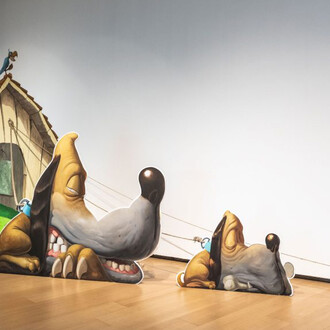This project draws from ancient Chinese methods of knowledge and philosophies in which the concept of darkening, often symbolized by the eclipse or a mountain guarding a flame inside it, opens up a field of possibilities rooted in the tension between natural and artificial forces. In this context, the artworks on view in this exhibition explore paths where the material, the emotional and the spiritual intersect in various elemental convergences, only to later unfold in very different forms that echo human, vegetal and animal traits. The eclipse, the veiling of the sun by the moon, or the darkening of light are metaphors to rethink the cycles of the passing of time on our planet, the influence of celestial bodies on it, and how they leave a lasting mark on processes of dissolution, erosion and transformation of materialities on the Earth. That being said, it also encourages us to explore in greater depth how a series of narratives are unfolded. As such, the project is a call to awaken a sensorial dimension.
The exhibition is made up of works of different kinds where the pictorial, sculptural and installation suggest different ways of confronting the processes of creation through intuition, the appreciation of the symbolic, the commitment to the body and the perception of the different fields of reality. Thus, the group exhibition includes works by Pablo Capitán del Río, Fuentesal Arenillas, Eleni Gkinosati, Mercedes Mangrané, Eduardo Martín del Pozo, Antonio Menchen, Belén Rodríguez, Silvestre Moros, Cristina Spinelli and Darío Villalba.
En las noches más oscuras lucen las más brillantes estrellas is envisioned as a poetic journey— one that invites viewers to construct unstable atmospheres and embrace digressive visual fields that are materially rich and conceptually open-ended. By allowing ghostly presences to take shape and illuminate what flickers or glows, these works guide us toward a reality that embraces the unresolved and the impermanent.
(Curatorial text by Johanna Caplliure)














